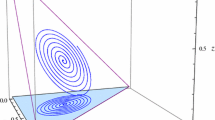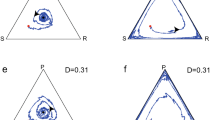Abstract
In this work, important aspects of bacteriocin producing bacteria and their interplay are elucidated. Various attempts to model the resistant, producer and sensitive Escherichia coli strains in the so-called rock–scissors–paper (RSP) game had been made in the literature. The question arose whether there is a continuous model with a cyclic structure and admitting an oscillatory dynamics as observed in various experiments. The May–Leonard system admits a Hopf bifurcation, which is, however, degenerate and hence inadequate. The traditional differential equation model of the RSP-game cannot be applied either to the bacteriocin system because it involves positive interaction terms. In this paper, a plausible competitive Lotka–Volterra system model of the RSP game is presented and the dynamics generated by that model is analyzed. For the first time, a continuous, spatially homogeneous model that describes the competitive interaction between bacteriocin-producing, resistant and sensitive bacteria is established. The interaction terms have negative coefficients. In some experiments, for example, in mice cultures, migration seemed to be essential for the reinfection in the RSP cycle. Often statistical and spatial effects such as migration and mutation are regarded to be essential for periodicity. Our model gives rise to oscillatory dynamics in the RSP game without such effects. Here, a normal form description of the limit cycle and conditions for its stability are derived. The toxicity of the bacteriocin is used as a bifurcation parameter. Exact parameter ranges are obtained for which a stable (robust) limit cycle and a stable heteroclinic cycle exist in the three-species game. These parameters are in good accordance with the observed relations for the E. coli strains. The roles of growth rate and growth yield of the three strains are discussed. Numerical calculations show that the sensitive, which might be regarded as the weakest, can have the longest sojourn times.
Similar content being viewed by others
References
Ambroziĉ J., Ostroverŝnik A., Starĉiĉ M., Kuhar I., Grabnar M., Zgur-Bertok D. (1998). Escherichia coli ColV plasmid pRK100: genetic organization, stability and conjugal transfer. Microbiology 144: 343–352
Axelrod R., Hamilton W.D. (1981). The evolution of cooperation. Science 211(4489): 1390–1396
Bockelman B., Deng B., Green E., Hines G., Lippitt L., Sherman J. (2004). Chaotic coexistence in a top-predator mediated competitive exclusive web. J. Dyn. Differ. Equ. 16(4): 1061–1092
Butler G., Freedman H.I., Waltman P. (1986). Uniformly persistent systems. Proc. Am. Math. Soc. 96(3): 425–430
Chao L., Levin B.R. (1981). Structured habitats and the evolution of anticompetitor toxins in bacteria. Proc. Natl. Acad. Sci. USA 78(10): 6324–6328
Chi S.-B., Hsu C.-W., WuL-I (1998). On the asymmetric May–Leonard model of three competing species. SIAM J. Appl. Math. 58(1): 211–226
Coste J., Peyraud J., Coullet P. (1979). Asymptotic behaviors in the dynamics of competing species. SIAM J. Appl. Math. 36: 516–543
Czárán T.L., Hoeckstra R.F., Pagie L. (2002). Chemical warfare between microbes promotes biodiversity. Proc. Natl. Acad. Sci. USA 99(2): 786–790
Denison R.F., Kiers E.T. (2004). Lifestyle alternatives for rhizobia: mutualism, parasitism and forgoing symbiosis. FEMS Microbiol. Lett. 237(4): 309–38
Diekmann O., Gyllenberg M., Metz J.A. (2003). Steady-state analysis of structured population models. Theor. Popul. Biol. 63(4): 309–38
Dykes G.A., Hastings J.W. (1997). Selection and fitness in bacteriocin-producing bacteria. Proc. R. Soc. Lond. B Biol. Sci. 264: 683–687
Feng Z., Smith L.S., McKenzie F.E., Levin S.A. (2004). Coupling ecology and evolution: malaria and the S-gene across time scales. Math. Biosci. 189: 1–19
Frank S.A. (1996). Models of parasite virulence. Q. Rev. Biol. 71(1): 37–78
Frean M., Abraham E.R. (2001). Rock–scissors–paper and the survival of the weakest. Proc. R. Soc. Lond. B Biol. Sci. 268: 1323–1327
Gardner A., West S.A., Buckling A. (2004). Bacteriocins, spite and virulence. Proc. R. Soc. Lond. B Biol. Sci. 271: 1529–1535
Govaerts, W., Kuznetsov, Y.A., De Feo, O., Dhooge, A., Govorukhin, V., Khoshsiar Ghaziani, R., Meijer, H.G.E., Mestrom, W., Riet, A., Sautois, B.: MATCONT. http://www.matcont.ugent.be/
Grohmann E., Muth G., Espinosa M. (2003). Conjugative plasmid transfer in Gram-positive bacteria. Microbiol. Mol. Biol. Rev. 67(2): 277–301
Guckenheimer J.A., Holms P.J. (1983). Nonlinear Oscillations, Dynamical Systems and Bifurcations of Vector Fields. Springer, New York
Hauert C., De Monte S., Hofbauer J., Sigmund K. (2002). Volunteering as red queen mechanism for cooperation in public goods games. Science 296: 1129–1132
Hirsch M.W. (1988). Systems of differential equations which are competitive or cooperative: III. Competing species. Nonlinearity 1: 051–07
Hofbauer J., So J.W.H. (1994). Multiple limit cycles for three-dimensional Lotka–Volterra equations. Appl. Math. Lett. 7(6): 65–70
Hofbauer J., Sigmund K. (1998). Evolutionary Games and Population Dynamics. Cambridge University Press, Cambridge
Hofbauer J., Sigmund K. (1988). The Theory of Evolution and Dynamical Systems. Cambridge University Press, Cambridge
Horn R.A., Johnson C.R. (1985). Matrix Analysis. University Press, Cambridge
Huisman J., Weissing F.J. (2001). Biological conditions for oscillations and chaos generated by multispecies competition. Ecology 82(10): 2682–2695
Hurwitz A. (1895). On the conditions under which an equation has only roots with negative real parts. Math. Ann. 46: 273–284
Ifti M., Bergersen B. (2004). Crossover behaviour of 3-species systems with mutations or migrations. Eur. Phys. J. B 37: 101–107
Iwasa Y., Nakamaru M., Levin S.A (1998). Allelopathy of bacteria in a lattice population: competition between colicin-sensitive and colicin-producing strains. Evol. Ecol. 12: 785–802
Kerr B., Riley M.A., Feldman M.W., Bohannan B.J.M. (2002). Local dispersal promotes biodiversity in a real-life game of rock–paper–scissors. Nature 418: 171–174
Kirkup B.C., Riley M.A. (2004). Antibiotic-mediated antagonism leads to a bacterial game of rock-paper-scissors in vivo. Nature 428: 412–414
Kuznetsov Y.A. (2004). Elements of Applied Bifurcation Theory, 3rd edn. Springer, Berlin
Levin S.A. (2000). Multiple scales and the maintenance of biodiversity. Ecosystems (N. Y., Print) 3: 498–506
May R.M., Leonard W.J. (1975). Nonlinear aspects of competition between three species. SIAM J. Appl. Math. 29(2): 243–253
Maynard-Smith J., Price G.R. (1973). The logic of animal conflict. Nature 246: 15–18
Murray J.D. (2002). Mathematical Biology: I. An Introduction. Springer, New York
Neumann G., Schuster S. (2007). Modeling the Rock–Scissors–Paper Game between Bacteriocin Producing Bacteria by Lotka–Volterra Equations. DCDS-B 8(1): 207–228
Pfeiffer T., Schuster S., Bonhoeffer S. (2001). Cooperation and competition in the evolution of ATP-producing pathways. Science 292: 504–507
Pfeiffer T., Schuster S. (2005). Game-theoretical approaches to studying the evolution of biochemical systems. Trends Biochem. Sci. 30(1): 20–25
Riley M.A. (1998). Molecular mechanisms of bacteriocin evolution. Annu. Rev. Genet. 32: 255–278
Riley M.A., Wertz J.E. (2002). Bacteriocin diversity: ecological and evolutionary perspectives. Biochimie 84(5–6): 357–364
Riley M.A., Wertz J.E. (2002). Bacteriocins: evolution, ecology and application. Annu. Rev. Microbiol. 56: 117–37
Schreiber S.J. (2000). Criteria for C r robust permanence. J. Differ. Equ. 162: 400–426
Semmann D., Krambeck H-J., Millinski M. (2003). Volunteering leads to rock-paper-scissors dynamics in a public goods game. Nature 425: 390–393
Sinervo B., Lively C.M. (1996). The rock–paper–scissors game and the evolution of alternative male strategies. Nature 380: 240–243
Sinervo, B.: Runaway social games, genetic cycles driven by alternative male and female strategies, and the origin of morphs. Genetica 112–113, 417–434 (2001)
Smith, H.: Monotone dynamical systems: an introduction to the theory of competitive and cooperative systems Mathematical Surveys and Monographs, vol. 41, AMS, Providence, RI (1995)
Smith H.L., Waltman P. (1994). The Theory of the Chemostat: Dynamics of Microbial Competition. Cambridge University Press, Cambridge
Szabó G., Szolnoki A., Izsák R. (2004). Rock–scissors–paper game on regular small-world networks. J. Phys. A Math. Gen. 37: 2599–2609
Tagg J.R., Dajani A.S., Wannamaker L.W. (1975). Bacteriocin of a group B streptococcus: partial purification and characterization. Antimicrob. Agents Chemother. 7(6): 764–772
van den Driessche P., Zeeman M.L. (1998). Three-dimensional competitive Lotka–Volterra systems with no periodic orbits. SIAM J. Appl. Math. 58: 227–234
van den Driessche P., Zeeman M.L. (2004). Disease induced oscillations between two competing species. SIAM J. Appl. Dyn. Syst. 3(4): 601–619
Vu-Delcarte, C.D.: Normal Forms and Bifurcations of Vector Fields. Perruquettiet, W., Barbot, J.P. (eds.) Chaos in automatic control, Chap. 3. Taylor & Francis, New York (2005)
Wilhelm T., Heinrich R. (1996). Mathematical analysis of the smallest chemical reaction system with Hopf bifurcation. J. Math. Chem. 19: 111–130
Xiao D., Li W. (2000). Limit cycles for the competitive three dimensional Lotka–Volterra systems. J. Differ. Equ. 164: 1–15
Zeeman M.L. (1993). Hopf bifurcations in competitive three dimensional Lotka–Volterra systems. Dyn. Stab. Syst. 8(3): 189–217
Author information
Authors and Affiliations
Corresponding author
Rights and permissions
About this article
Cite this article
Neumann, G., Schuster, S. Continuous model for the rock–scissors–paper game between bacteriocin producing bacteria. J. Math. Biol. 54, 815–846 (2007). https://doi.org/10.1007/s00285-006-0065-3
Received:
Revised:
Published:
Issue Date:
DOI: https://doi.org/10.1007/s00285-006-0065-3




